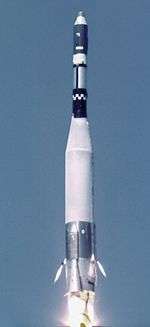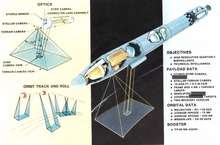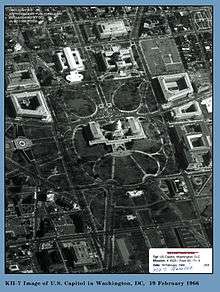KH-7 Gambit

Codenamed Gambit, the KH-7 (Air Force Program 206) was a reconnaissance satellite used by the United States from July 1963 to June 1967. Like the older Corona system, it acquired imagery intelligence by taking photographs and returning the undeveloped film to earth. It achieved a typical ground-resolution of 2 ft (0.61 m) to 3 ft (0.91 m).[1] Though most of the imagery from the KH-7 satellites was declassified in 2002, details of the satellite program (and the satellite's construction) remained classified until 2011.[2]
In its summary report following the conclusion of the program, the National Reconnaissance Office concluded that the Gambit project was considered highly successful in that it produced the first high resolution satellite photography, 69.4% of the images having a resolution under 3 ft. (0.91 m); its record of successful launches, orbits, and recoveries far surpassed the records of earlier systems; and it advanced the state of the art to the point where follow-on larger systems could be developed and flown successfully. The report also stated that Gambit had provided the intelligence community with the first high resolution satellite photography of denied areas, the intelligence value of which was considered "extremely high".[1] In particular, its overall success stood in sharp contrast to the two first-generation photoreconnaissance programs, Corona, which suffered far too many malfunctions to achieve any consistent success, and Samos, which was essentially a complete failure with all satellites either being lost in launch mishaps or returning no usable imagery.
Gambit emerged in 1962 as an alternative to the less-than-successful Corona and the completely failed Samos, although Corona was not cancelled and in fact continued operating alongside the newer program into the early 1970s. While Corona used the Thor-Agena launch vehicle family, Gambit would be launched on Atlas-Agena, the booster used for Samos. After the improved KH-8 satellite was developed during 1965, operations shifted to the larger Titan IIIB launch vehicle.
System configuration




Each Gambit 1 satellite was about 15 feet (4.5 m) long, 5 feet (1.5 m) wide, weighed about 1,154 pounds (523 kilograms), and carried about 3000 feet (914 meters) of film. [3]
A feasibility study for the Geodetic Orbital Photographic Satellite System reveals three subsystems for US optical reconnaissance satellites in the 1960s: the Orbital (or Orbiting) Control Vehicle (OCV), the Data Collection Module (DCM), and the Recovery Section (RS).[4] For the KH-7, the DCM is also called the Camera Optics Module (COM), and is integrated in the OCV, which has a length of 5.5 m (18 ft) and a diameter of 1.52 m (5 ft 0 in).[5]
Camera Optics Module
The Camera Optics Module of KH-7 consists of three cameras: a single strip camera, a stellar camera, and an index camera.
In the strip camera the ground image is reflected by a steerable flat mirror to a 1.21 m (48 in) diameter stationary concave primary mirror. The primary mirror reflects the light through an opening in the flat mirror and through a Ross corrector. It took images of a 6.3 degree wide ground swath by exposing a 22 cm (8.7 in) wide moving portion of film through a small slit aperture.[6][7] The initial ground resolution of the satellite was 1.2 meters (4 ft), but improved to 0.6 m (2 ft) by 1966. Each satellite weighed about 2000 kg, and returned a single film bucket per mission. The camera and film transport system were manufactured by Eastman Kodak Company.[7]
The index camera is a copy of cameras systems previously used in the KH-4 and KH-6 satellites, and takes exposures of Earth in direction of the vehicle roll position for attitude determination. The stellar camera takes images of star fields with a reseau grid being superimposed on the image plane.[6] The S/I camera was provided by Itek, and horizon sensors were provided by Barnes Engineering Co.[1]
Orbital Control Vehicle and Recovery Vehicle

The primary contractor for the Orbital Control Vehicle and the Recovery Vehicle was General Electric.[1] Films were to be retrieved mid-air by a C-130 Hercules specially outfitted for that purpose.[8]
Mission
All KH-7 satellites were launched from Point Arguello, which became part of Vandenberg Air Force Base in July 1964. KH-7 satellites flew 38 missions, numbered 4001-4038, of which 34 returned film, and of these, 30 returned usable imagery. Mission duration was 1 to 8 days.[9] KH-7 satellites logged a total of almost 170 operational days in orbit.[1]
Functionality

A high-resolution instrument, the KH-7 took detailed pictures of "hot spots" and most of its photographs are of Chinese and Soviet nuclear and missile installations, with smaller amounts of coverage of cities and harbors.[10] Most of the imagery from this camera, amounting to 19,000 images, was declassified in 2002 as a result of Executive order 12951,[11] the same order which declassified Corona, and copies of the films were transferred to the U.S. Geological Survey's Earth Resources Observation Systems office.[12] Approximately 100 frames covering the state of Israel remain classified.[13]
In early 1964, the CIA toyed with the idea of using Gambit to photograph military installations in Cuba, but this was dismissed as unworkable as the satellites were primarily designed with higher-latitude Soviet territory in mind and because it would mean wasting an entire satellite on the Latin America-Caribbean area which had little else of interest to US intelligence services. It was decided that U-2 spyplane flights were more-than adequate to provide coverage of Cuban activity.
ELINT subsatellite
Mission 4009 included an ELINT P-11 subsatellite for radar monitoring, which was launched into a higher orbit.[14][15]
List of launches

| Name | Mission No. | Launch Date | Alt. Name | NSSDC ID No. | Launch Vehicle | Perigee (km) | Apogee (km) | Inclination (deg) |
|---|---|---|---|---|---|---|---|---|
| KH7-1 | 4001 | 1963-07-12 | OPS-1467 | 1963-028A | Atlas Agena D | 164 | 164 | 95.4 |
| KH7-2 | 4002 | 1963-09-06 | OPS-1947 | 1963-036A | Atlas Agena D | 168 | 263 | 94.4 |
| KH7-3 | 4003 | 1963-10-25 | OPS-2196 | 1963-041A | Atlas Agena D | 144 | 332 | 99.1 |
| KH7-4 | 4004 | 1963-12-18 | OPS-2372 | 1963-051A | Atlas Agena D | 122 | 266 | 97.9 |
| KH7-5 | 4005 | 1964-02-25 | OPS-2423 | 1964-009A | Atlas Agena D | 173 | 190 | 95.7 |
| KH7-6 | 4006 | 1964-03-11 | OPS-3435 | 1964-012A | Atlas Agena D | 163 | 203 | 95.8 |
| KH7-7 | 4007 | 1964-04-23 | OPS-3743 | 1964-020A | Atlas Agena D | 150 | 366 | 103.6 |
| KH7-8 | 4008 | 1964-05-19 | OPS-3592 | 1964-024A | Atlas Agena D | 141 | 380 | 101.1 |
| KH7-9 | 4009 | 1964-07-06 | OPS-3684 | 1964-036A | Atlas Agena D | 121 | 346 | 92.9 |
| KH7-10 | 4010 | 1964-08-14 | OPS-3802 | 1964-045A | SLV-3 Agena D | 149 | 307 | 95.5 |
| KH7-11 | 4011 | 1964-09-23 | OPS-4262 | 1964-058A | SLV-3 Agena D | 145 | 303 | 92.9 |
| KH7-12 | 4012 | 1964-10-08 | OPS-4036 | 1964-F11 | SLV-3 Agena D | --- | --- | --- |
| KH7-13 | 4013 | 1964-10-23 | OPS-4384 | 1964-068A | Atlas Agena D | 139 | 271 | 88.6 |
| KH7-14 | 4014 | 1964-12-04 | OPS-4439 | 1964-079A | SLV-3 Agena D | 158 | 357 | 97 |
| KH7-15 | 4015 | 1965-01-23 | OPS-4703 | 1965-005A | SLV-3 Agena D | 146 | 291 | 102.5 |
| KH7-16 | 4016 | 1965-03-12 | OPS-4920 | 1965-019A | SLV-3 Agena D | 93 | 155 | 0.0 |
| KH7-17 | 4017 | 1965-04-28 | OPS-4983 | 1965-031A | SLV-3 Agena D | 180 | 259 | 95.7 |
| KH7-18 | 4018 | 1965-05-27 | OPS-5236 | 1965-041A | SLV-3 Agena D | 149 | 267 | 95.8 |
| KH7-19 | 4019 | 1965-06-25 | OPS-5501 | 1965-050B | SLV-3 Agena D | 151 | 283 | 107.6 |
| KH7-20 | 4020 | 1965-07-12 | OPS-5810 | 1965-F07 | SLV-3 Agena D | --- | --- | --- |
| KH7-21 | 4021 | 1965-08-03 | OPS-5698 | 1965-062A | SLV-3 Agena D | 149 | 307 | 107.5 |
| KH7-22 | 4022 | 1965-09-30 | OPS-7208 | 1965-076A | SLV-3 Agena D | 98 | 164 | 95.6 |
| KH7-23 | 4023 | 1965-11-08 | OPS-6232 | 1965-090B | SLV-3 Agena D | 145 | 277 | 93.9 |
| KH7-24 | 4024 | 1966-01-19 | OPS-7253 | 1966-002A | SLV-3 Agena D | 150 | 269 | 93.9 |
| KH7-25 | 4025 | 1966-02-15 | OPS-1184 | 1966-012A | SLV-3 Agena D | 148 | 293 | 96.5 |
| KH7-26 | 4026 | 1966-03-18 | OPS-0879 | 1966-022A | SLV-3 Agena D | 162 | 208 | 101 |
| KH7-27 | 4027 | 1966-04-19 | OPS-0910 | 1966-032A | SLV-3 Agena D | 139 | 312 | 116.9 |
| KH7-28 | 4028 | 1966-05-14 | OPS-1950 | 1966-039A | SLV-3 Agena D | 133 | 358 | 10.5 |
| KH7-29 | 4029 | 1966-06-03 | OPS-1577 | 1966-048A | SLV-3 Agena D | 143 | 288 | 86.9 |
| KH7-30 | 4030 | 1966-07-12 | OPS-1850 | 1966-062A | SLV-3 Agena D | 137 | 236 | 95.5 |
| KH7-31 | 4031 | 1966-08-16 | OPS-1832 | 1966-074A | SLV-3 Agena D | 146 | 358 | 93.3 |
| KH7-32 | 4032 | 1966-09-16 | OPS-1686 | 1966-083A | SLV-3 Agena D | 148 | 333 | 93.9 |
| KH7-33 | 4033 | 1966-10-12 | OPS-2055 | 1966-090A | SLV-3 Agena D | 155 | 287 | 91 |
| KH7-34 | 4034 | 1966-11-02 | OPS-2070 | 1966-098A | SLV-3 Agena D | 159 | 305 | 91 |
| KH7-35 | 4035 | 1966-12-05 | OPS-1890 | 1966-109A | SLV-3 Agena D | 137 | 388 | 104.6 |
| KH7-36 | 4036 | 1967-02-02 | OPS-4399 | 1967-007A | SLV-3 Agena D | 136 | 357 | 102.4 |
| KH7-37 | 4037 | 1967-05-22 | OPS-4321 | 1967-050A | SLV-3 Agena D | 135 | 293 | 91.5 |
| KH7-38 | 4038 | 1967-06-04 | OPS-4360 | 1967-055A | SLV-3 Agena D | 149 | 456 | 104.8 |
(NSSDC ID Numbers: See COSPAR)
History


- Section source: Space Review[7]
In early 1963, the Gambit program began with failures. On May 11, the first Gambit satellite sat atop its Atlas-Agena booster on Launch Complex SLC4W at Vandenberg Air Force Base awaiting launch. An air bubble formed while loading LOX into the booster and as soon as propellant filling was stopped, the bubble damaged the fill/drain valve. This quickly caused both the LOX and helium pressure gas to escape from the tank, depressurizing the Atlas's balloon skin and causing the entire launch vehicle to crumple to the ground. The RP-1 tank ruptured and spilled its contents onto the pad. There was no fire or explosion, but the Agena sustained minor damage and the satellite a considerable amount as the cameras were crushed in by impact with the ground and had their lenses destroyed. The pad itself was undamaged except for a steel beam cracked by exposure to the super-chilled LOX, which was repaired in two days. Fortunately, the satellite on the booster was not the same one planned for the actual launch and the payload shroud had also remained in one piece, preventing any unauthorized parties from seeing the GAMBIT. Secrecy surrounding the program was strict and knowledge of Gambit limited only to those directly involved in the program. While the early CORONA and Samos flights had been merely billed to the public as scientific missions, it became increasingly difficult to explain why they failed to return any scientific data. In late 1961, President John F. Kennedy ordered a veil of secrecy placed around the photoreconnaissance program and by GAMBIT's debut in 1963, DoD announcements described no details other than the launching of a "classified NRO payload".
A different booster was used and the first successful Gambit mission was launched on July 12, 1963. The launch vehicle performed perfectly and inserted Gambit into polar orbit with a 102-mile (189 kilometers) altitude. The Air Force designated this mission number 4001.
Aerospace Corporation recommended that, during Gambit’s first flights, the Orbital Control Vehicle (OCV) should remain attached to the Agena. This was a proven successful process for other Agena tests; and whereas the OCV was not. This decision limited Gambit's functionality, meaning that photographs could only be taken of targets directly below the vehicle. Once the successful photographic phase of the mission 4002 was completed, the OVC and the Agena was separated and the reentry vehicle would come down into the ocean northwest of Hawaii. The re-entry vehicle was caught in mid-air with a C-130 Hercules aircraft using a modified version of the Fulton surface-to-air recovery system. The film canister was then immediately transported to Eastman Kodak's Hawkeye facility in Rochester, New York for processing.[16] The developed results was sent to US Air Force imagery research analysts in Washington, DC.
GAMBIT mission 4003, was launched on October 25, 1963. The film canister was again ejected successfully after the photographic phase and the capsule recovered by an aircraft. Other tests was carried out with the OCV.
GAMBIT mission 4004 was launched and its film canister recovered on December 18, 1963. Missions 4005 through 4007 were also successful.
In May 1964, mission 4008 suffered major problems when the Agena did an unexplained roll during the boost phase. Even with OCV system problems, the film canister was able to return some imagery.
A variety of problems occurred with many of the remaining missions including poor or no imagery. Many of these difficulties were caused by the unreliable wire recording system carried by the Gambits (tape recorders were not yet in widespread use in the mid-1960s). Two satellites ended up in the Pacific Ocean; 4012 on 8 October 1964 suffered an Agena engine malfunction and 4020 on 12 July 1965 impacted some 620 miles downrange after the Atlas's onboard computer sent a premature shutdown command to the sustainer engine. The latter was the first flight witnessed by newly arrived Brig. Gen John L. Martin who replaced Maj. Gen Robert Greer as head of the KH-7 program. Martin cracked down and began demanding higher workmanship and quality standards. He is credited with having significantly improved the success rate of the program.
It was noted that the Gambit flights through the first half of 1964 had been mostly successful, but a string of malfunctions occurred starting in the second half of the year and continuing through the first half of 1965. These included the two above-mentioned launch failures plus GAMBIT 4013 which did not return any imagery and 4014 which suffered a battery explosion. 4019 did not return any imagery either. Eventually, it was determined that the culprit was an extra structure added to the SLC-4W umbilical tower that sent resonant vibration through the Atlas-Agena stack at liftoff, jarring random components in the booster and/or spacecraft loose.
The KH-7 Gambit was an overall success, even with some failures; thus providing National Reconnaissance Office and the President with quality intelligence collection. Following KH projects had greatly improved major upgrades in the spacecraft and its camera systems.
Cost
The total cost of the 38 flight KH-7 program from FY1963 to FY1967, without non-recurring costs, and excluding five Gambit cameras sold to NASA, was US$651.4 million in 1963 dollars (inflation adjusted US$ 5.04 billion present day).[17] Non-recurring costs for industrial facilities, development, and one-time support amounted to 24.3% of the total program cost, or US$209.1 million. The resulting total program costs were US$860.5 million in 1963 dollars (inflation adjusted US$ 6.66 billion present day).[1]
Other U.S. imaging spy satellites
- Corona series: KH-1, KH-2, KH-3, KH-4
- Samos
- KH-5 ARGON, KH-6 Lanyard
- KH-7 and KH-8 Gambit
- KH-9 Hexagon "Big Bird"
- KH-10 -- MOL
- KH-11
References
- 1 2 3 4 5 6 "Summary Analysis of Program 206 (GAMBIT)" (PDF). National Reconnaissance Office. 1967-08-29.
- ↑ Flashlights in the dark, The Space Review
- ↑ "Declassified US Spy Satellites from Cold War Land in Ohio". SPACE.com. Retrieved 2015-10-11.
- ↑ "Feasibility Study Final Report: Geodetic Optical Photographic Satellite System, Volume 2 Data Collection System" (PDF). National Reconnaissance Office. June 1966. Retrieved 2010-12-19.
- ↑ Day, Dwayne A. (2010-11-29). "Black Apollo". www.thespacereview.com. Retrieved 2010-12-17.
- 1 2 "KH-7 Camera System- Part I". National Photographic Interpretation Center. July 1963.
- 1 2 3 Day, Dwayne A. (2010-11-29). "Ike's gambit: The development and operations of the KH-7 and KH-8 spy satellites". www.thespacereview.com. Retrieved 2009-01-25.
- ↑ "Key Hole (KH)". Retrieved 4 November 2015.
- ↑ "NRO review and redaction guide (2006 ed.)" (PDF). National Reconnaissance Office.
- ↑ NARA ARC database description of "Keyhole-7 (KH-7) Satellite Imagery, 07/01/1963 - 06/30/1967", accession number NN3-263-02-011
- ↑ "National Archives Releases Recently Declassified Satellite Imagery". National Archives and Records Administration press release. 2002-10-09.
- ↑ edc.usgs.gov
- ↑ "Historical imagery declassification". National Geospatial-Intelligence Agency.
- ↑ "1964-036B". NASA National Space Science Data Center. 2010-10-08.
- ↑ Day, Dwayne (2009-04-27). "Robotic ravens: American ferret satellite operations during the Cold War". thespacereview.com.
- ↑ "National Reconnaissance Office Review and Redaction Guide: Appendix C - Glossary of Code Words and Terms" (PDF). National Reconnaissance Office. 2008.
- ↑ "The GAMBIT story". National Reconnaissance Office. June 1991.
- Mark Wade (August 9, 2003). KH-7. Encyclopedia Astronautica. Accessed April 23, 2004.
- KH-7 Gambit. GlobalSecurity.org.
- Gallery of KH-7 pictures at USGS
- NIMA 2002 Declassification FAQ (mirror at GlobalSecurity.org).
External links
- US Geological Survey Satellite Images: Photographic imagery from KH-7 Surveillance and KH-9 Mapping system (1963 to 1980).